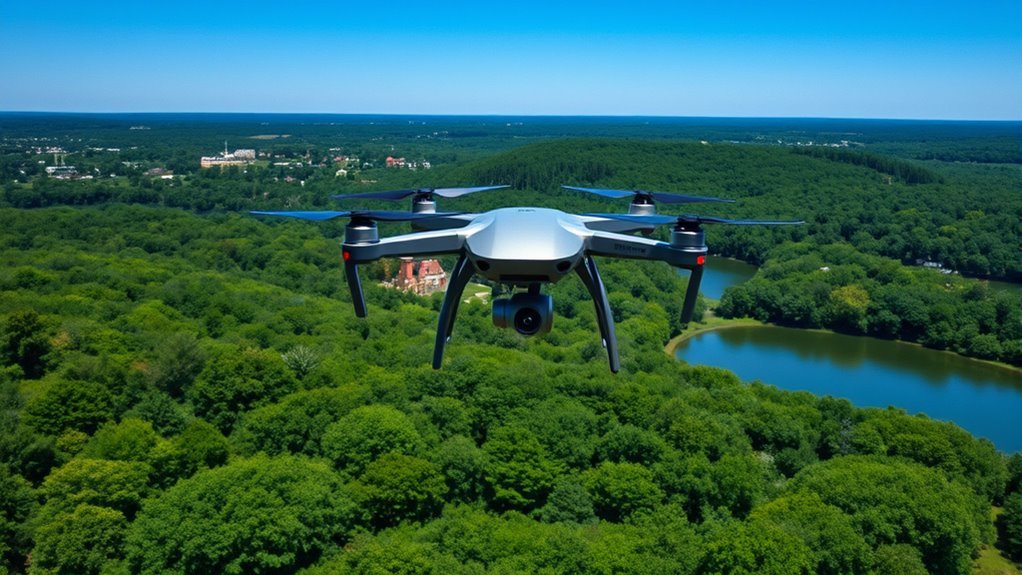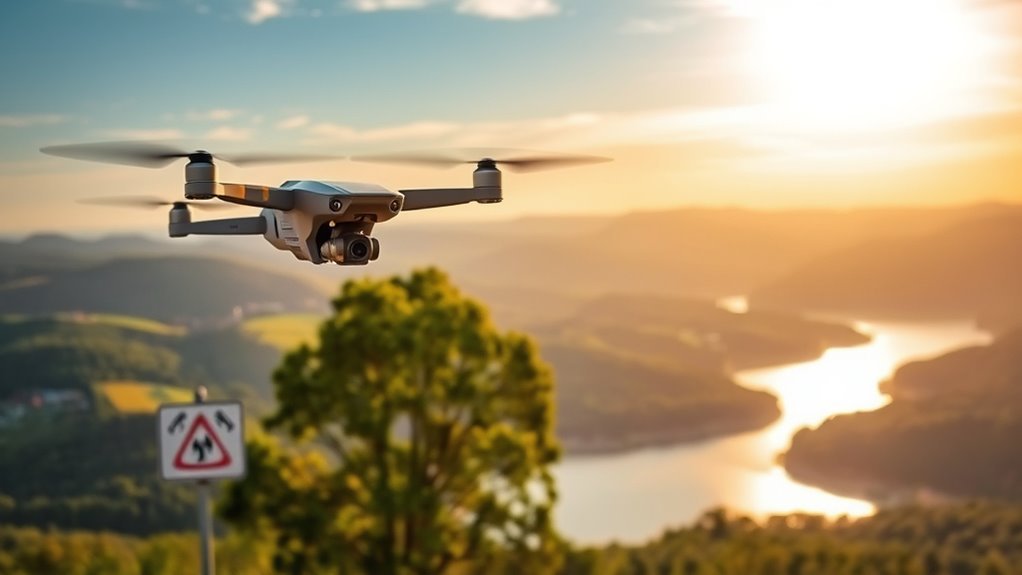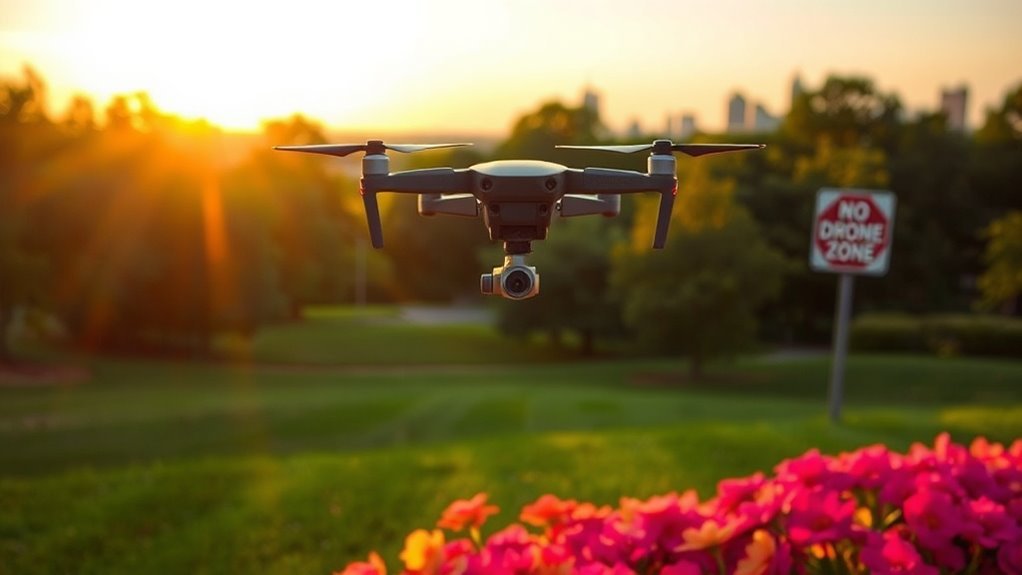In Connecticut, you must follow federal FAA rules and state laws when flying drones. If your drone weighs over 0.55 pounds, you need to register it with the FAA and get a Remote Pilot Certificate to operate it legally. You also must avoid no-fly zones like airports and respect privacy by not capturing images without consent. Commercial users have additional restrictions and insurance requirements. Understanding these basics guarantees safe, lawful flight—and there’s more to know about specific regulations and penalties.
Overview of Drone Laws in Connecticut

Although federal regulations primarily govern drone operations across the United States, Connecticut has enacted specific state laws that you need to follow when flying drones within its borders. These laws address concerns unique to the state’s environment and public safety, balancing your freedom to operate with responsible usage of drone technology. Connecticut’s statutes focus on privacy protections, prohibiting the use of drones to capture images or data without consent in private settings. Additionally, restrictions are placed on drone flights over certain public areas to address public perception and safety concerns. Understanding these state-specific requirements guarantees you can navigate Connecticut’s airspace legally and confidently, maintaining respect for both technological advancement and community standards. Staying informed helps you exercise your rights without compromising others’ privacy or safety.
Drone Registration Requirements

Besides understanding Connecticut’s privacy and flight restrictions, you’ll need to comply with drone registration requirements that apply at both federal and state levels. If your drone weighs more than 0.55 pounds (250 grams), you must register it with the FAA before flying. The registration process is straightforward but mandatory to operate legally. While Connecticut does not impose additional registration beyond FAA rules, you should maintain current drone insurance to protect against liabilities. Keep your registration details updated, especially if you change ownership. Regular drone maintenance is also vital to guarantee compliance with safety standards and to prevent accidents that could jeopardize your operational freedom. Adhering to these registration requirements safeguards your ability to fly freely while respecting the regulatory framework.
Pilot Certification and Operating Rules

You’ll need to obtain the proper pilot certification to operate drones legally in Connecticut, meeting all federal and state requirements. Understanding specific flight operation limitations, such as altitude restrictions and no-fly zones, is vital to maintain compliance. Additionally, keeping your drone registered and following established rules guarantees safe and lawful use.
Certification Requirements Overview
When operating a drone in Connecticut, you must comply with specific pilot certification and operating rules established by both federal and state authorities. To fly legally and confidently, you’ll need to meet certification requirements that guarantee safety and accountability. This includes obtaining a Remote Pilot Certificate from the FAA, which verifies your knowledge of airspace regulations and operational procedures. Additionally, maintaining your drone in peak condition and securing appropriate drone insurance are critical for risk management and legal compliance. Key certification requirements include:
- Passing the FAA’s Aeronautical Knowledge Test
- Registering your drone with the FAA
- Maintaining up-to-date drone maintenance records
- Carrying valid drone insurance coverage
Following these rules grants you the freedom to operate within Connecticut’s airspace responsibly and without legal obstacles.
Flight Operation Limitations
Meeting certification requirements sets the foundation for lawful drone operation, but understanding flight operation limitations is equally important to confirm compliance. When flying in Connecticut, you must adhere to specific weight limits—typically under 55 pounds—to avoid additional regulations. Staying within the maximum flight altitude of 400 feet above ground level ensures you don’t interfere with manned aircraft or restricted airspace. You’re also required to keep your drone within visual line-of-sight at all times, which enhances safety and control. Operating rules prohibit flights over people, moving vehicles, or restricted zones without explicit authorization. By respecting these parameters, you maintain operational freedom while aligning with state and federal mandates, avoiding penalties, and confirming your drone flights remain both safe and lawful.
Registration and Compliance
Although drone flight operation requires adherence to specific limitations, guaranteeing proper registration and compliance with pilot certification and operating rules is equally critical. You must register your drone with the FAA if it weighs over 0.55 pounds, linking it to your identity. Obtaining a Remote Pilot Certificate, especially for commercial use, demonstrates your mastery of drone technology and legal requirements. Compliance guarantees not only your legal freedom to operate but also the safety of others, which drone insurance can further secure. Remember to:
- Register your drone accurately and display the registration number.
- Pass the FAA’s knowledge test for pilot certification.
- Follow operational rules like altitude limits and no-fly zones.
- Maintain current drone insurance to mitigate liability risks.
Staying compliant preserves your right to fly freely while respecting regulatory frameworks.
Restrictions on Drone Flight Locations
You must avoid flying drones in designated no-fly zones, including near airports and sensitive government facilities. Respecting privacy laws is essential to prevent unauthorized surveillance of private property. Understanding these location-based restrictions is critical for compliant and safe drone operations in Connecticut.
No-Fly Zones
Since drones operate in shared airspace, it’s crucial to understand the designated no-fly zones in Connecticut. These restrictions are critical for ensuring drone safety and effective airspace management. You’ll need to avoid flying in areas where your drone could interfere with manned aircraft or sensitive operations. Key no-fly zones include:
- Within 5 miles of airports without prior authorization
- Near military installations and government buildings
- Over emergency response scenes, such as fires or accidents
- Inside national parks and designated wildlife refuges
Respecting these zones isn’t just about compliance; it protects your freedom to fly safely by preventing accidents and legal issues. Always check updated maps and notifications before you launch to maintain responsible operation within Connecticut’s airspace.
Privacy Considerations
When operating drones in Connecticut, understanding privacy considerations is vital to avoid violating personal rights and local laws. You must be aware that drone surveillance is heavily regulated to protect individuals from unauthorized data collection. Flying over private property without explicit permission can lead to legal repercussions under Connecticut’s data protection statutes. It’s important to respect boundaries where expectation of privacy exists, such as residential backyards or fenced areas. Your drone operations should avoid capturing identifiable personal information unless you have proper consent. Additionally, Connecticut law restricts the use of drones in ways that infringe upon privacy rights, emphasizing responsible use that balances freedom with respect for others. Staying compliant guarantees your drone activities remain lawful and ethically sound.
Proximity to Airports
Although drones offer remarkable flexibility, operating them near airports in Connecticut is subject to strict regulations designed to guarantee aviation safety. You must understand that airport proximity triggers specific flight restrictions to protect manned aircraft and secure safe airspace management. Before flying close to any airport, you’re required to:
- Obtain authorization from the FAA via the LAANC system or a waiver.
- Maintain a minimum distance of 5 miles from airports unless permission is granted.
- Avoid flying within controlled airspace without explicit clearance.
- Notify airport operators and air traffic control when necessary.
Adhering to these rules secures your drone operations remain lawful and safe, preserving your freedom to fly while respecting critical aviation boundaries and minimizing risks associated with airport proximity.
Privacy Laws Affecting Drone Use
Because drones can easily capture images and videos from private properties, understanding Connecticut’s privacy laws is essential for anyone operating these devices. You must respect limits on drone surveillance to avoid infringing on others’ reasonable expectation of privacy. Connecticut’s data protection statutes further regulate how you handle any collected information, ensuring responsible use and storage.
| Aspect | Regulation Summary | Your Responsibility |
|---|---|---|
| Drone Surveillance | Prohibited over private property without consent | Obtain consent or avoid private areas |
| Audio Recording | Generally banned without consent | Do not record audio surreptitiously |
| Data Protection | Requires secure handling of captured data | Implement appropriate safeguards |
| Legal Recourse | Civil penalties for violations | Understand potential liabilities |
| Public Spaces | Surveillance allowed with fewer restrictions | Know where you can legally operate |
Respecting these laws preserves your freedom while protecting others.
Rules for Commercial Drone Operations
Understanding privacy laws is just one part of operating drones responsibly in Connecticut. When you’re flying drones for commercial use, you must also comply with specific state and federal requirements. To maintain your operational freedom legally, keep these key points in mind:
- Obtain a Remote Pilot Certificate from the FAA before commercial flights.
- Register your drone with the FAA and display the registration number.
- Secure adequate drone insurance to cover potential liabilities.
- Operate within FAA Part 107 rules, including altitude limits and daylight-only flights unless waivers are granted.
Adhering to these regulations guarantees you can conduct commercial drone operations confidently and without legal interruptions, balancing your freedom with public safety and privacy protections.
Penalties for Violating Drone Regulations
If you fail to comply with Connecticut’s drone regulations, you’ll face strict penalties designed to enforce safe and lawful operation. Enforcement agencies, including the Connecticut State Police and the Federal Aviation Administration (FAA), actively monitor compliance and investigate violations. Penalties can include significant fines for violations, which vary based on the severity and nature of the infraction. These fines are intended to deter reckless or unauthorized drone use that threatens public safety or privacy. In addition to monetary penalties, repeat or egregious offenses may lead to the suspension or revocation of your drone registration or pilot certification. Understanding and adhering to these regulations is essential to maintain your freedom to fly while avoiding costly consequences imposed by enforcement agencies committed to preserving safe airspace.
Tips for Safe and Legal Drone Flying in Connecticut
Flying drones safely and legally in Connecticut requires adhering to specific guidelines that protect both your equipment and the public. To maintain freedom while respecting the law, you must follow best practices and flying etiquette that guarantee responsible operation. Always:
- Register your drone with the FAA if it weighs over 0.55 pounds.
- Keep your drone within visual line of sight and below 400 feet.
- Avoid flying near airports, emergency response efforts, or over private property without permission.
- Respect privacy by not capturing images or videos where people expect confidentiality.

